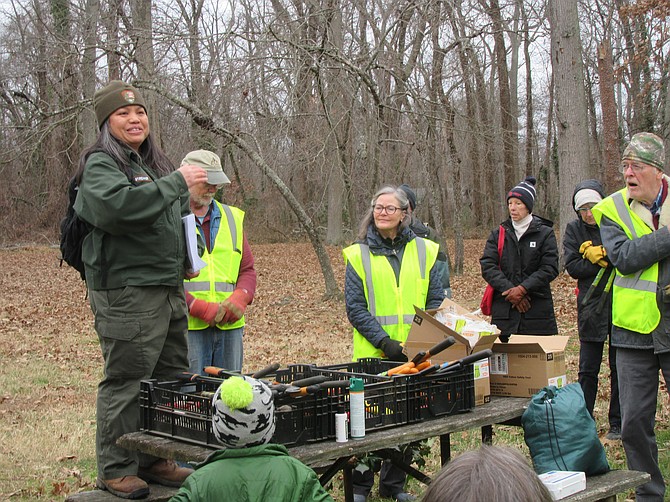Get ready to applaud brown, dying English ivy clinging to many of the George Washington Memorial Parkway’s trees, many people hope. At a Jan. 21 National Park Service training for 45 anti-ivy crusaders in Fort Hunt Park, park service employees Mireya Stirzaker and Trudy Roth conducted a hands-on training on ivy’s harm, how to remove it and save trees.
NPS partnered with the Mount Vernon Council of Citizen Associations (MVCCA), a civic organization that has many neighborhoods bordering the parkway. The response to the recruiting email was so enthusiastic that the Park Service had to close the registration when RSVPs hit 50 because they did not have enough trainers or tools for a larger group.
“English ivy forms a monoculture, crowds out valuable native plants and takes nutrients, water and light from native plants,” Stirzaker explained. She said that the plant is rampant in the entire parkway’s 7,600 acres and commended the group for wanting “to take care of the places that you love.”
“I hate English ivy. It’s evil,” said Tauxemonter Alyssa Pease, as she clipped it off a tree.
Her neighbor, Joan Ullman, said she went to the training because “I’m really bothered when I see it up and down the parkway.”
Stirzaker and Roth gave a tutorial on what they called “the window treatment.” Using hand pruners, loppers and handsaws, they cut a “window” or gap in the ivy vine by snipping near the tree’s base and again at knee or waist height and removing the cut vine from the tree. “This technique helps eliminate ‘ladders’ for new vine growth and makes it easy to see which trees have been cleared,” said Stirzaker. The ivy eventually dies.
She also explained that mature English ivy has berries that birds eat and then spread. “We are one bird poop away from disaster,” she said, once the birds eat the berries, adding that the berries have minimal nutritional value. “It’s like sending birds to McDonalds,” she quipped.
Jim McGlone, a state forester, added native plants’ berries generally have a higher fat content than ivy’s.
By becoming trained, the volunteers were “deputized” to adopt an area along the parkway and work on their own. NPS staff hope volunteers will help long term. Riverside residents Tom Myers and Kathy Davis said they are pleased that they can now go after ivy on the parkway whenever they want and help “the trees, the poor things,” Kathy said.
“Our mantra is ‘free the trees,’” urged Stirzaker.
George Washington Memorial Parkway Superintendent Charles Cuvelier emailed, “These volunteer events are so important in helping the National Park Service remove harmful invasive species like English ivy. It also allows members of the community an opportunity to give back and help the park preserve its natural resources.”
English ivy (Hedera helix) is a perennial, aggressive plant. Its aerial rootlets attach to the object it climbs and when mature, it flowers.
Ivy vines “that climb up trees slowly kill the tree from the base upwards by enveloping branches and twigs, blocking sunlight, causing branch and eventual tree death,” says Plant Invaders of the Mid-Atlantic Natural Areas. Also, trees weighed down with vines are more vulnerable to blowing or falling down during rain, snow and ice storms. Ivy can trap moisture on the tree trunk and accelerate tree rot. It can also damage stucco, wood, mortar, siding and shingles if it grows up walls.
Around 20 percent of the parkway’s plants are not native, according to NPS biologists. Most of those are invasive, introduced from other areas both accidentally and deliberately, have few controls, impair biodiversity and destroy native habitats.
Trees sequester carbon, reduce other pollution, stem stormwater runoff, reduce cooling costs and provide habitat for birds and other wildlife. The parkway is losing many ash trees because of the invasive emerald ash borer. Many oaks are suffering too regionwide. Overabundant deer eat young saplings which alters forest succession and prevents regeneration of plants.
The Park Service will hold another training in the spring on controlling ivy and other invasives.
Congress authorized the construction of the Mount Vernon Memorial Parkway as a grand gateway to George Washington’s home, Mount Vernon. The south section opened in 1932 to honor the bicentennial of Washington’s birth. It is on the National Register of Historic Places.
The designers intended it to be a slow-speed, scenic road combining the natural, historic and recreational sites along its route. The landscape design emphasizes scenic vistas and natural areas and integrates the road with the undulating terrain following natural contours. It has minimal signs and lights. Healthy, native trees are an integral part of that design and consistent with Congress’s intent.
The Virginia section of the Parkway runs 25 miles from Mount Vernon Estate north to I-495 in Maryland, generally paralleling the Potomac River.
Volunteer
To volunteer, visit https://www.nps.gov/gwmp/getinvolved/volunteer.html.
Resources
Native plants: Plant NOVA Natives, https://www.plantnovanatives.org/; Virginia Native Plant Society at https://vnps.org/.
Invasive plants: https://www.invasive.org/eastern/midatlantic/.